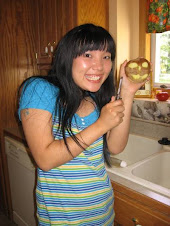Written Chinese --
Written Chinese characters comes in two main forms -- traditional and simplified. Traditional Chinese is the "original" Chinese character language. Traditional Chinese is mainly used in Taiwan (Republic of China), Hong Kong and Macau. Simplified Chinese was created by decreasing the number of strokes and simplifying the forms of a sizable proportion of traditional Chinese characters. Simplified Chinese is mainly used in the People's Republic of China (Mainland China) and Singapore. Therefore, most of your kiddos will be used to simplified Chinese characters.
Pinyin is a written phonetic representation of simplified Chinese using the English alphabet. For example, the simplified Chinese character for "love" is  . The pinyin for "love" is "ai". In public schools in China the kiddos learn the Chinese characters as well as the pinyin for each character. The one slight drawback of pinyin is that there may be several different meanings for each pinyin grouping so just having the pinyin may not tell you the exact meaning of the intended character. For example, in paperwork you'll probably be given your child's Chinese name in pinyin and then you'll wonder what the meaning of the name is. In order to get the true meaning, you'll need the character representation to assure accuracy in translating.
. The pinyin for "love" is "ai". In public schools in China the kiddos learn the Chinese characters as well as the pinyin for each character. The one slight drawback of pinyin is that there may be several different meanings for each pinyin grouping so just having the pinyin may not tell you the exact meaning of the intended character. For example, in paperwork you'll probably be given your child's Chinese name in pinyin and then you'll wonder what the meaning of the name is. In order to get the true meaning, you'll need the character representation to assure accuracy in translating.
 . The pinyin for "love" is "ai". In public schools in China the kiddos learn the Chinese characters as well as the pinyin for each character. The one slight drawback of pinyin is that there may be several different meanings for each pinyin grouping so just having the pinyin may not tell you the exact meaning of the intended character. For example, in paperwork you'll probably be given your child's Chinese name in pinyin and then you'll wonder what the meaning of the name is. In order to get the true meaning, you'll need the character representation to assure accuracy in translating.
. The pinyin for "love" is "ai". In public schools in China the kiddos learn the Chinese characters as well as the pinyin for each character. The one slight drawback of pinyin is that there may be several different meanings for each pinyin grouping so just having the pinyin may not tell you the exact meaning of the intended character. For example, in paperwork you'll probably be given your child's Chinese name in pinyin and then you'll wonder what the meaning of the name is. In order to get the true meaning, you'll need the character representation to assure accuracy in translating.Why is pinyin important? Well, because pinyin is how your kiddo can use electronic translators and computer keyboards. The electronic translators that many parents purchase in China are used by typing in the pinyin and then using the results to select the correct character. Once the correct character is selected then the translator can display the English equivalent. So if your kiddo does not know pinyin, then he/she will not be able to use an electronic translator. Also, once you are home you can use a program on your computer that will allow your kiddo to type in pinyin and the then a box will pop up with all the possible Chinese characters with the pinyin. Then the user just picks the desired character.
Spoken Chinese --
For spoken Chinese, my understanding is that there are actually 7 main dialects: Mandarin (850 million speakers), Wu (90 million speakers), Yue (includes Cantonese)(80 million speakers), Min (50 million speakers), Xiang (35 million speakers), Hakka (35 million speakers) and Gan (20 million speakers). There are also many, many, many, many local dialects. The two dialects we hear most about are Mandarin and Cantonese. Mandarin is the official language of the People's Republic of China and spoken primarily in Northern and Southwestern China. Cantonese is spoken in and around the city of Guangzhou (formerly known as Canton), in most of Guangdong province, eastern Guangxi province, Hong Kong and Macau. While the spoken words in these dialects sound different, the words are written exactly the same!
Also, I'm told that in schools now most kids learn Mandarin as well as their local dialects, so if your child has been out to public school then there is a good chance he/she knows Mandarin even if he/she is from a location where another dialect is spoken. However, if your child has been in orphanage school solely then he/she may only know his/her local dialect.
Why does this matter to adoptive parents? First, if you are wanting to learn some Chinese before you travel to meet your kiddo you'll want to be learning the same dialect your child speaks. A few parents have commented they tried to learn a bit of Mandarin only to find out their child only spoke Cantonese. Second, if you are arranging a tutor or translator for when you return home, make sure that person can communicate in your son's or daughter's dialect.




2 comments:
Thank you!!!
I am LOVING these posts!! You are my mentor :) Thank you!!
Dawn
hoping to travel next month for my almost 12 y.o. girl
Post a Comment